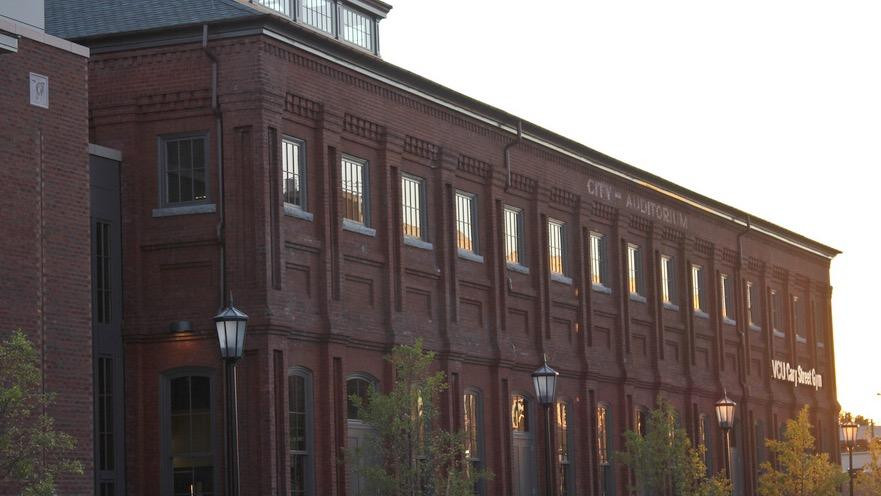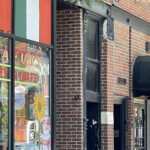Richmond’s Cary Street Gym is more than just a place to work out; it’s a landmark with a fascinating 130-year history. This impressive red brick building, prominently located on bustling Cary Street, has witnessed Richmond’s evolution firsthand. While today it’s known as Virginia Commonwealth University’s (VCU) Cary Street Gym, a modern fitness center for students, its walls hold stories of farmers, performers, and even presidents. Look closely, and you’ll see the faint inscription “City Auditorium” above the current signage – a whisper of its vibrant past.

Originally designed by Richmond architect Marion J. Dimmock, this building wasn’t intended for pumping iron or treadmills. In the early 1890s, it was conceived as the Third Market, a farmers market aimed at serving the growing population of Sydney, now known as the Fan District. Richmond’s First and Second Markets were thriving, and the Third Market was envisioned to alleviate overcrowding and provide fresh produce to this expanding residential area.
From Farmers Market to City Auditorium: An Entertainment Era
The Third Market officially opened its doors in 1895, boasting 140 stalls and an architectural style reminiscent of grand European department stores. Despite its promising start, the market failed to capture the public’s attention, with the original First and Second Markets retaining their popularity. Recognizing the need for a change, the City of Richmond decided to repurpose the underutilized space.
In 1907, the building was reborn as the City Auditorium, transforming into a premier entertainment venue. This marked a significant turning point in the building’s history, ushering in an era of music, politics, and community gatherings. The City Auditorium quickly became a cultural hub, hosting a diverse range of events that drew crowds from across Richmond and beyond.
A Stage for Legends and Leaders
The City Auditorium’s stage became a platform for a remarkable array of talent and significant events. Its inaugural major event was the Confederate Reunion of 1909, a gathering to honor and commemorate Confederate soldiers. The Richmond News Leader, a prominent local newspaper, also held meetings within its walls, and the Richmond Musicians Club regularly graced its stage.
Audiences at the City Auditorium were treated to performances by world-renowned artists, including Russian composer Sergei Rachmaninoff, Polish pianist Jan Paderewski, and celebrated composer John Philip Sousa. Opera star Geraldine Farrar and humorist Will Rogers also entertained crowds, solidifying the auditorium’s reputation as a top-tier entertainment destination.
The auditorium also played host to notable figures beyond the realm of arts and entertainment. United States Presidents William Howard Taft, Woodrow Wilson, and Herbert Hoover all delivered speeches from its stage, further cementing its importance in Richmond’s civic life. However, not all speakers were universally admired. Billy Sunday, a former baseball player turned evangelist known for his controversial views, also held sermons there, sparking debate with his outspoken opinions on politics, women, and alcohol.
Challenges and the Rise of New Venues
Despite its success, the City Auditorium faced practical challenges. Ventilation relied solely on windows, which, when opened to combat the heat generated by large crowds, allowed street noise to disrupt performances and speeches.
In 1927, the opening of the opulent Mosque Theater (now Altria Theater) marked a turning point. This new, state-of-the-art venue, built at a cost of $1.65 million, offered a level of luxury and modern amenities that the City Auditorium couldn’t match. Consequently, the City Auditorium’s prominence as a major entertainment venue diminished, and it became relegated to smaller events and high school graduations.
From Sports Arena and Wartime Garage to VCU Gym
The City Auditorium continued to evolve, transitioning into a sports arena where wrestling matches drew enthusiastic crowds. Among the wrestlers who competed there was Eddie Blanks, known as “Red Devil,” who later became an instructor at VCU, adding another layer to the building’s VCU connection.
World War II brought another transformation. The auditorium was repurposed as a garage and repair shop for emergency vehicles, serving the war effort. After the war, it became a City warehouse for four decades, its entertainment days seemingly long behind it.
In 1978, Virginia Commonwealth University acquired the building, breathing new life into the historic structure and establishing the Cary Street Gym. The initial gym facilities were basic, featuring a large hardwood floor for basketball and two courts. Connie Kottmann, a long-time employee of VCU Recreational Sports, recalls the early gym as having a mezzanine for group exercise, a small cardio and weight room, and racquetball courts. Offices were located on the ground floor, described as “dark and cramped.”
Modernization and Preservation: The Cary Street Gym Today
Recognizing the growing student population and the need for modern recreational facilities, VCU undertook a significant renovation and expansion project in the early 2000s. While modernizing the gym, VCU prioritized preserving the building’s historical character. “The original brickwork is intact,” Kottmann notes. “And if you look carefully around the gym, you can see old carvings in some of the bricks.” The original roof was replaced with energy-efficient materials, but the roofline was meticulously copied to maintain the historic aesthetic. Even the support poles in the fitness center are in their original locations.
An adjacent carriage house, dating back to the 19th century, was also saved and relocated to house the Outdoor Adventure Program, further demonstrating VCU’s commitment to preserving the site’s history. The expansion was carefully designed to complement the surrounding neighborhood, with features like the “porches” on Cherry Street reflecting the residential architecture across the street.
The renovated Cary Street Gym is a state-of-the-art recreation center, boasting a 40-foot climbing wall, an aquatic center with two pools, an indoor track, an 18,000 square-foot fitness center, and much more. It serves approximately 4,000 users daily during the academic year and has received LEED-Gold certification for its energy efficiency and sustainable design. The Cary Street Gym has also garnered architectural accolades and was recognized as the second most impressive college recreation center by Best Value Schools in 2013.
From its humble beginnings as a farmers market to its current role as a bustling university gym, the Cary Street Gym building has been a witness to Richmond’s history and a vital part of the community for 130 years. Its walls echo with the voices of farmers, musicians, politicians, and students, reminding us that even as Richmond evolves, its historical landmarks continue to play a vibrant role in the city’s present and future.
— ∮∮∮ —
Sources
- Griggs, W. (2012). The Richmond City Auditorium. In Hidden history of Richmond. Charleston, SC: History Press.
- The Cary Street Gym: A Brief History. (2010, October 4). Retrieved November 11, 2015
- Famous ‘Booze’ Sermon. (n.d.). Retrieved November 11, 2015
- Theater History. (n.d.). Retrieved November 11, 2015
- Worsham, G. (2012, December 2). Richmond’s Second and Third Markets. Retrieved November 11, 2015

